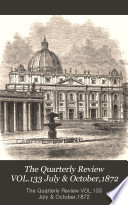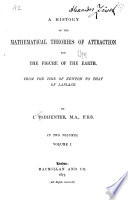 Every particle of matter in the universe attracts every other particle with a force varying directly as the product of their masses and inversely as the square of the distance between them. Every particle of matter in the universe attracts every other particle with a force varying directly as the product of their masses and inversely as the square of the distance between them.  Outlines of elementary physiography - Page 4by George Thom (principal of Dollar inst.) - 1881Full view Outlines of elementary physiography - Page 4by George Thom (principal of Dollar inst.) - 1881Full view - About this book
 | Thomas Rawson Birks - Change of state (Physics) - 1862 - 254 pages
...their correspondence with the known phenomena of physical change. CHAPTER I. ON MATTER AND ETHER. 1. EVERY particle of matter attracts every other particle, with a force varying inversely as the square of the distance between them. This is the great discovery of Newton, which... | |
 | Richard Anthony Proctor - 1865 - 312 pages
...phenomena to general theories— in the grand cosmical law : — ' Every particle of matter in the universe attracts every other particle with a force varying directly as the product of the masses and inversely as the square of the distance.' Under this law the satellites sweep round their primaries,... | |
 | Richard Anthony Proctor - Astronomy - 1865 - 302 pages
...phenomena to general theories—in the grand cosmical law :—' Every particle of matter in the universe attracts every other particle with a force varying directly as the product of the masses and inversely as the square of the distance.' Under this law the satellites sweep round their primaries,... | |
 | Sidney Augustus Norton - Physics - 1870 - 518 pages
...gravity of the two bodies. The law of gravitation, discovered in 1666 by Sir Isaac Newton, is usually stated as follows: Every particle of matter attracts every other particle with a force (1.) direcHy proportional to its mass, and (2.) inversely proportional to the square of its distance.... | |
 | William Guy Peck - Mechanics - 1870 - 332 pages
...universe. This law, sometimes called the Newtonian law of universal gravitation, may be enunciated as follows : Every particle of matter attracts every other particle, with a force that varies directly as the mass of the attracting particle, and inversely as the square of the distance... | |
 | William Gifford, Sir John Taylor Coleridge, John Gibson Lockhart, Whitwell Elwin, William Macpherson, William Smith, Sir John Murray IV, Rowland Edmund Prothero (Baron Ernle) - English literature - 1872 - 616 pages
...each other on the earth. The sequence is inevitable. The second instance is the law of gravitation. Every particle of matter attracts every other particle, with a force varying inversely as the square of the distance. This causes the motion of the sun, moon, planets, and stars;... | |
 | William Gifford, Sir John Taylor Coleridge, John Gibson Lockhart, Whitwell Elwin, William Macpherson, William Smith, Sir John Murray IV, Rowland Edmund Prothero (Baron Ernle) - English literature - 1872 - 620 pages
...each other on the earth. The sequence is inevitable. The second instance is the law of gravitation. Every particle of matter attracts every other particle, with a force varying inversely as the square of the distance. This causes the motion of the sun, moon, planets, and stars... | |
 | English literature - 1872 - 614 pages
...each other on the earth. The sequence is inevitable. The second instance is the law of gravitation. Every particle of matter attracts every other 'particle, with a force varying inversely as the square of the -distance. This causes the motion of the sun, moon, planets, and stars... | |
 | Isaac Todhunter - Attractions of ellipsoids - 1873 - 520 pages
...the direction always passes through the centre : see also Art. 56. But if we admit with Newton that every particle of matter attracts every other particle with a force varying inversely as the square of the distance, bodies will no longer necessarily be attracted exactly towards... | |
 | Sidney Augustus Norton - Physics - 1875 - 302 pages
...gravity of the two bodies. The law of gravitation, discovered in 1 666 by Sir Isaac Newton, is usually stated as follows: Every particle of matter attracts every other particle, with a force (1) directly proportional to its mass, and (2) tnversely proportional to the square of its distance.... | |
| |